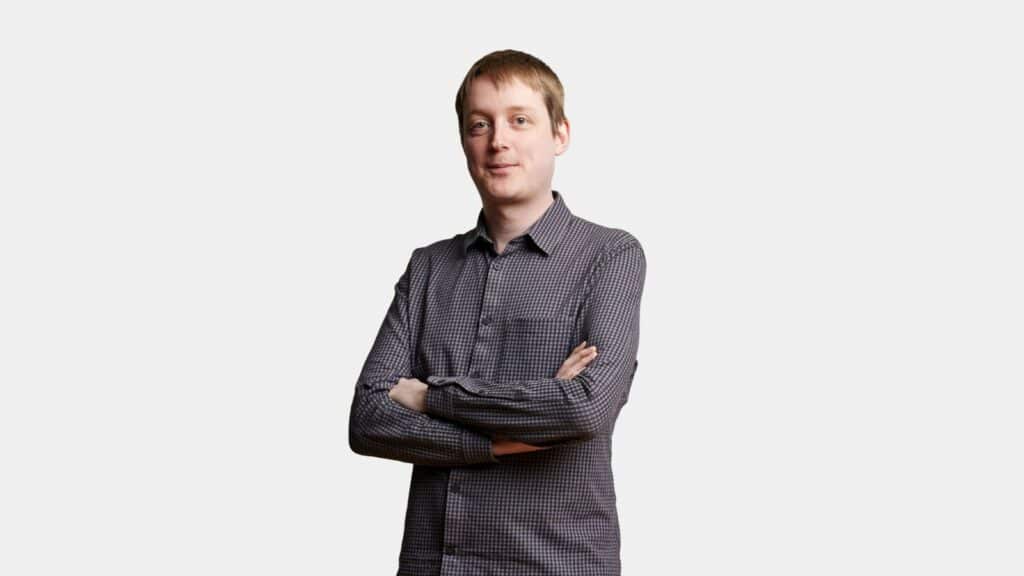Everybody’s talking about AI. Despite fears milling around about the implications the technology might have on jobs and creativity in the agency world, plenty of businesses are experimenting with AI tools to spark new ideas, with some even launching their own solutions.
This piece first appeared in Prolific North’s Northern Agency Guide – order your copy here.
Whether AI tools are used to speed up processes or serve as a source of inspiration to get those creative juices flowing, we’ve spoken to a number of Northern agencies to find out how and why they are embracing AI…
With a wealth of experience across software engineering, solution architecture and mobile app development, James Hall, director at Parallax is no stranger to the evolution of tech.
He believes AI is no longer a “distant, out-of-reach concept”, adding that Parallax is “tackling it head on”.

“That’s why we’re continuously experimenting with creative ways to use AI. We often try things out for ourselves, then apply our learnings to client partnerships, and successfully integrate AI into their operations.”
The Leeds-based digital consultancy launched its own app in July 2022, using OpenAI to categorise content and eliminate the requirement and costs of a third-party integration.
“Day-to-day, we’re iterating and refining our use of AI for our own business processes and products, as well as developing an ethical approach to quality assurance and deployment.
“Our core AI technology offering is FluencyBot, an OpenAI-powered chatbot that integrates with Confluence and Slack to find the answers you need quickly, without having to sift through lots of content yourself.
“We’re also looking at ways to advance our tech not only for business operations and streamlining information access – but also improve our service delivery for clients.
“We’re exploring how we can use AI for more in-depth analysis of things like interviews, surveys, and customer tickets. We’re not just talking about sorting and organising data, but actual evaluation and interpretation to make sense of it and use it effectively.”
By using AI to “make things smoother, simpler, and more efficient,” Parallax is already working on a number of AI-powered proof-of-concept projects for its clients, ranging anywhere from smarter website searches to event booking tools.
“We’re genuinely excited about the unique possibilities that AI brings for both ourselves and our clients,” he adds.
“We’re not only investing time and resources into AI R&D, and internal ‘hack days’ where we’ve been using LLMs and AI for some time now, but also sharing our findings with the wider community through our regular Applied AI events. It’s not about being seen as an AI thought leader; it’s about ensuring we all move forward with the help of AI – our team, our clients, and the industry at large.”
“You need the right creative minds”
Over at Tangent, AI isn’t just a talking point. The digital agency recently built its entire summer party around the future of AI in the digital industry.
Tom Walsh, head of marketing, said: “In June, we threw a Hackathon called ‘Product Palooza’ designed to bring together the full range of expertise from across Tangent’s global team, spanning design, development, tech, project management and beyond to collaborate and bring new products powered by artificial intelligence to life – all in one working day. The brief? To solve problems and make ways of working easier within our agency or for our clients.”
Beyond experimenting, Tangent has been applying AI in real products for some of the brands it works with such as recruitment company Reed and workspace network IWG.
“For Reed, there are a series of tools powered by AI in development, designed to enhance the employee and employer experience during the recruitment process and your career lifecycle.
“Though the theory behind this (top secret) tool is quite simple, the number of variables this technology navigates (including role, seniority, hard/soft skills, etc.) are numerous. The benefit of using AI in this case is the capacity for the tool to learn and refine over time. It is hugely scalable, operating across any sector, and has the capacity to deliver massive impact for the brand, placing Reed at the centre of innovation in a crowded marketplace.”
Although he recognises opportunities are “truly limitless” when it comes to AI, he argues “you need the right creative minds and expertise to generate dynamic ideas and then bring them to life”.
Jack Sails, head of HX at IMA-HOME, agrees. AI is helping his agency to jump-start the creative process, not replace it, helping its talented team to overcome that occasional “daunting blank page”.

“We aim to create an environment where our teams feel empowered to use AI confidently, safely and responsibly. AI isn’t a threat or a novelty, but an opportunity. It’s like giving everyone a personal assistant that’s always ready to lend a helping hand,” he explains.
“Whether that means automating repetitive tasks, uncovering elusive insights, expanding on ideas, or sparking new creations, we know that AI has a place in our agency. The AI debate, certainly in our view of our industry, has never been about replacing human talent. Our people remain our most valuable asset, and their creativity is our greatest strength.”
“We’re riding this wave of rapid adoption”
43% of staff at the agency said they are already integrating at least one AI platform into their workflow occasionally.
“We’re riding this wave of rapid adoption to test, innovate and separate the hot air from the genuinely transformative platforms and models that will make a difference both to us and to our clients.
“The future of AI at IMA-HOME is about embracing these powerful tools responsibly. We see it as a positive force, and we’re eager to explore where it will take us in the months and years to come. Our journey with AI is just beginning, and we’re committed to ensuring it enriches our work rather than defines it.”
Similarly, digital product and design consultancy Code Computerlove is embracing the benefits of AI in a number of ways – from basic writing for emails, blog posts and even summarising meeting transcripts and suggesting key actions. An “obvious starting point” with AI tools was with any project involving writing.
“Efficiency gains with admin tasks have been positive, helping build basic prompting skills. The next focus has been the domain of our specialists, where we’re still exploring, but opens up the most exciting possibilities,” says Louis Georgiou, founder and director.

“Within UX, creating synthetic personas, simulated user interviews and then drafting full customer journeys is an area we’re experimenting with to assess the results compared with traditional processes. We’re not trialling it commercially yet, but our aim is to push the tech to see what’s feasible, whilst acknowledging this may become common practice in the future.”
Early on, the team encountered several major barriers to company-wide adoption and has been addressing them for the past four months.
“Putting aside the obvious legal, ethical and hallucination (false AI responses) concerns, the biggest barriers have been: Prompt engineering capabilities, reusable prompts for consistent, high quality results, tools access for all, and AI knowledge of bespoke approaches.
“Code is part of EssenceMediaCom and we’ve been working together on these challenges in two main workstreams. Firstly running Hackathons, discipline by discipline to surface relevant use cases and give teams opportunity to experiment writing prompts for text and image generation.
“The second has been the development of our proprietary AI tool, built on GPT4 and Midjourney, which provides unlimited usage for all our people with access to our knowledge base of approved prompt templates. It also ensures we can respect the data privacy of our clients too. Finally we’re extending its capabilities to store our custom methods and data, so responses will be more representative of our unique practices.”
As AI tools are still in their infancy, use of them over at The Behaviours Agency are in a beta phase too.
“Currently, we see AI tools, in their many guises, as explorative/helpful tools, not solution givers,” says deputy creative Phil Monks.

The creative team has been between exploring the capabilities of AI and how the application can benefit and elevate the agency’s skills and projects.
“For example, while we’re exploring the likes of Midjourney and the AI capabilities of Adobe Creative Suite’s beta programs, we’re doing it to draw inspiration for imagery for mock-ups, adcepts or scamps, not to deliver direct creative outputs. On the other hand, AI tools such as flair.ai and unscreen are helping our production team to efficiently create mockups of products in situ for presentations and edit videos when green screen isn’t used.”
When it comes to using AI tools for words, he argues it’s still “a bit one-dimensional”.
“The widely accessible AI tools for writing are based on producing content for blogs or posts on social channels. With the basis of our copywriting work being brand storytelling, AI doesn’t give us the human experience of language and understanding of the nuances in tone that we need.
“However, the space between exploration and application narrows between our departments. For example, AI offers scheduling (Reclaim), internal comms aggregator (Spoke) and text analyser (PDF.ai) tools that help our account management team be more efficient on admin tasks to focus on projects and growing client relationships.
“For us right now, the craft of human experience and skill still firmly outweighs the craft of prompt writing for AI. We’re constantly testing and learning to be ready for if/when this balance shifts. Being part of a Channel 4 News initiative: ‘Agency VS AI’ has brought this reality even closer… watch out for more on that soon!”
For Rob Illidge, founder of Social Republic, his agency has embraced the use of AI to help “improve and speed up processes”.

“Our teams see this as a unique opportunity to add value to the social media services we offer and to do more of the work we love,” he says.
“Organic and paid teams have been leveraging OpenAI to research, plan and improve the content they create, offering a unique method of expanding upon campaign ideas.
“Designers have also benefited from the advancements in AI, utilising Adobe Firefly to instantly extend and fill images, whilst making the most of video editing tools within Premiere Pro which reduces editing times.”
Similarly to a number of agencies, Social Republic has also created its own AI platform called Vulse after seeing the difficulties users face when trying to craft engaging LinkedIn content.
“Vulse helps those who may not require an agency or don’t have the budget to allocate to an external team. We partnered with Manchester Metropolitan University to develop unique AI features that help users to plan, create and analyse relevant LinkedIn posts.”
Like most agencies, Edge45 were both fascinated and slightly worried by the power of AI tools when they first appeared, says CEO and founder Colm Docherty.

“We’ve realised that, when used as part of our workflow and not replacing actual human content creators, they can be highly useful.”
Edge45 has set up its own AI Content Generation service to help create a variety of different content from blog posts to imagery. Whether it’s using ChatGPT, Midjourney or Photoshop’s Generative Fill, these AI tools are used alongside its team of content experts.
“Our in-house content experts have the knowledge of the client, their specific industry and the SEO requirements. We add this – along with the human creativity that AI so often lacks – to the AI tool to help us create parts of the content faster, while still retaining the signature of human personality.”
In agreement with the other agency leaders we’ve chatted to, although AI tools are great to kick-start the creative process, a human will always be needed to guide it.
“As we know, AI needs high-quality input in the form of prompts to make sure what we’re getting is perfect for the client – as well as amends and checks on the output to make sure it hits all our SEO guidelines, feels natural and engaging and is factually correct. We also then need to consider the specific client needs, add quotes and internal hyperlinks.
“But what AI does is speed up some forms of content creation, allowing us to provide our clients with high quality – often highly technical – content at a rate we couldn’t before.”
“Rather than having AI drive out innovation…we’ve switched this around to see how innovation can be aided by AI”
Meanwhile Anna Wilson, chief digital innovation officer at Tangerine, says the marcomms industry is only just starting to see the potential the technology can have.

“Embracing the potential AI has to increase effectiveness, analysis and efficiency is something we have a huge focus on at Tangerine,” she explains. “So, rather than having AI drive our innovation, we’ve switched this around to see how our innovation can be aided by AI. Ultimately, no one is at the point where artificial intelligence can be operated as a solo act, and this means any implementation still needs a lot of human intelligence to actually work.”
Similarly to other agency founders, Tangerine is constantly “monitoring, testing and learning with AI and analytics is a great place to start”.
She adds: “We’re currently working on using AI within our measurement practices. Our recent Shapes of Attention report is a keen example of our exploration around sector innovations, and it’s this innovative way of buying and measuring media that is a perfect platform for AI – for example calculating Attention Audit Scores which measure both quantity and quality of attention and then to understand the impact of mid funnel activity and show how strategies can be adapted to boost conversion rates and reduce CPAs.
“There’s no doubt that AI will change our landscape, but for now it’s a tool to be used sparingly and monitored closely. Even though it has intelligence in the name, it doesn’t necessarily produce that when left to its own devices.”










